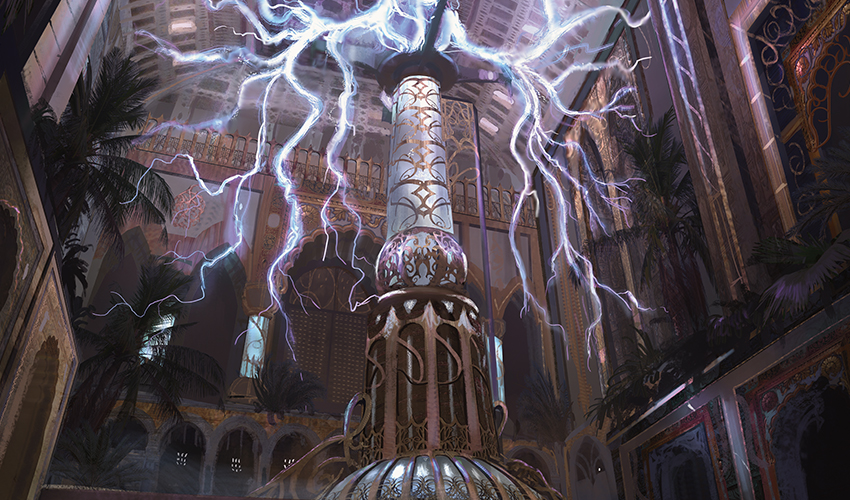Hold Up!
You're playing a version of Temur Dynavolt Tower in Standard. You sit down for Game 1 of a match and draw your opening hand.
Your seven cards are Forest, Spirebluff Canal, Botanical Sanctum, Attune with Aether, Harnessed Lightning, Harnessed Lightning, and Dynavolt Tower.
It's a pretty solid hand, especially against an unknown opponent. You're on the play, and you decide to keep.
It's your turn one. What do you do?
Well, it seems pretty obvious: Botanical Sanctum, Attune with Aether, right? The Sanctum is the right land to play since you want to get it out of your hand early, and Attune is a one-drop, so it's right to cast here.
. . . Or is it?
Let's investigate deeper.
Oh, Mana!
Here's an important takeaway to keep in mind: just because you have the mana to cast a spell, doesn't mean you should cast that spell.
I see this happen all the time. Removal spells blown on irrelevant creatures because you have spare mana at the end of your opponent's turn. Creatures overextended into a board sweeper just because you have them in your hand. Card selection cast before you even know what you're looking for. Like all plays in Magic, you should be deliberate with your actions: evaluate the game state and the information you have, see what matters, and decide from there.
In this situation described above, you have Attune with Aether in your hand. It costs one mana. You could cast it and go get a land right away, meaning you don't need to cast it on a future turn. That mana wasn't doing anything for you this turn.
So, why wait?
Two words: Dynavolt Tower.

If you don't need to cast the Attune now and have a free mana on a turn after you cast the Tower, you're picking up two additional energy. And in a deck where activating your Tower an extra time or not could be the difference between winning and losing, that could mean quite a lot!
In this situation, with this hand, I would not cast the Attune on the first turn. But it's not just that cut and dry: there are some hands with this deck where I absolutely would!
So, what do you need to take into account here? There are two fundamental questions to ask.
Future Sight
Will I have this mana on a future turn? What am I giving up by not playing this now?
Those are the big questions here. The opportunity cost of giving up the chance to cast it this turn really boils down to that in most cases.
For example, let's say you could somehow know that every turn for the rest of the game you're just going to have an extra green mana lying around every turn. Well, in that case, you could just hold onto that Attune. You'd always have the resources around to cast it.
But Magic isn't like that. You can't just bank this open mana for a future turn. So, it requires looking at your current hand and taking your best guess about what the future holds.
Let's take that original opening hand, but remove one of the lands from it for a Torrential Gearhulk, so you only have two lands. Now what?

Well, in that case I would absolutely fire off the Attune on the first turn. You are going to need a third land for your hand to operate, and on the second turn you will certainly have a play of some kind to make. You could draw a land in your next two draw steps, but if you miss on finding one, then you don't want to spend your third turn casting Attune for a land instead of Dynavolt Tower.
It's a single card difference—yet it entirely changes how you should play the first turn of the game.
What if your hand doesn't have the Dynavolt Tower and instead has a Torrential Gearhulk? Is it worth holding onto it for the chance you might draw one?
In this case, I would be inclined to cast the Attune now because I want to make sure I hit my land drops. However, with that said, if I had a fourth land in my hand (and not a Gearhulk), I would likely hold that Attune.
Being efficient with your mana is also incredibly important. If you give up the chance to cast it now, you don't want it to hinder you later. You don't want to lose with spells in your hand you could have otherwise cast . . . but, by the same token, you don't want to give up free value.
And that is really where the tension of using what you know about your hand and library to look into the future comes in.
Now, you can say there are other factors at play here. For example, thinning your library of a basic land if you cast the Attune now—but that is a fairly negligible benefit compared to the tangible strength of two additional energy. In each case, look at the card and think ahead: can you wait to cast this or are you giving up value by not playing it now? And, of course, it follows that the less expensive the card is to cast, the easier it is to leave in your hand
Let's look at another kind of card where this comes up.
Card Selection
Let's say you don't play Attune with Aether on turn one, and after a bit more passing back and forth, now it's the end step of your opponent's turn two. Should you cast that Anticipate?
Well . . . What are you looking for?
In addition to waiting on it because of the Dynavolt Tower, there's also the question of if it's worth waiting and being better informed.
To help explain, let me take you back to a different time. A time of Preordains.
Back in the days where an extremely powerful Standard deck named Caw-Blade ruled the roost (nest?), Preordain was a staple. Practically any blue deck played four Preordains (with a few rebels like Shaheen Soorani going the other direction), and they were crucial. However, there was a trick in knowing how and when to use them.
The Caw-Blade mirror match—a match that I unfortunately encountered during eleven of the sixteen rounds of a Grand Prix—saw a lot of Preordains cast. And whenever an opponent fired off a Preordain on the first turn, I always felt great about it.
As it turns out, unless you were missing lands or one of your crucial two-drops (Stoneforge Mystic or Squadron Hawk, for those curious), the right turn to cast Preordain was often turn three. You wanted the game to advance enough that you knew what you wanted out of your Preordain, and turn three gave you that plus let you play another two-drop. Did you need lands? Spells? Answers to an aggressive deck? Your dreaded Jace, the Mind Sculptors? You'd know a lot more if you let the game advance a bit.
Let's return to Anticipate now.
Anticipate is quite different from Preordain. For one, you can't scry any additional cards to the top. And for another, it costs two mana.
That difference is huge: the opportunity cost of waiting is doubled. Having one extra mana available on a turn for Attune might happen with this hand—but having two extra mana available could take a while.
In this situation, I would cast the Anticipate. (Assuming there isn't something you want to cast Harnessed Lightning on—it would still be nice to wait until post-Tower if possible.) But it's a good thing to be thinking about. If your deck curves low, for example, then maybe your plan is to just cast Dynavolt Tower on turn three and then Harnessed Lightning plus Anticipate on turn four for a healthy supply of energy.
But the moral of the story: think through if you should actually be casting any given card now. Sometimes, waiting is better.
Hurry up and Wait
This is an area of Magic that isn't discussed much, and hopefully it helped you see things in a different way! I know it was eye-opening to me the first time I realized it.
May you always Anticipate when to best cast your spells.
Have any thoughts or questions about this article? I'd love to hear from you! Please feel free to send me a tweet, a message on Tumblr, or a good ol' fashioned email by sending your thoughts to BeyondBasicsMagic@gmail.com. (In English, please.)
I'll be back next week with another Beyond the Basics. Have fun casting spells, and talk with you again then!

